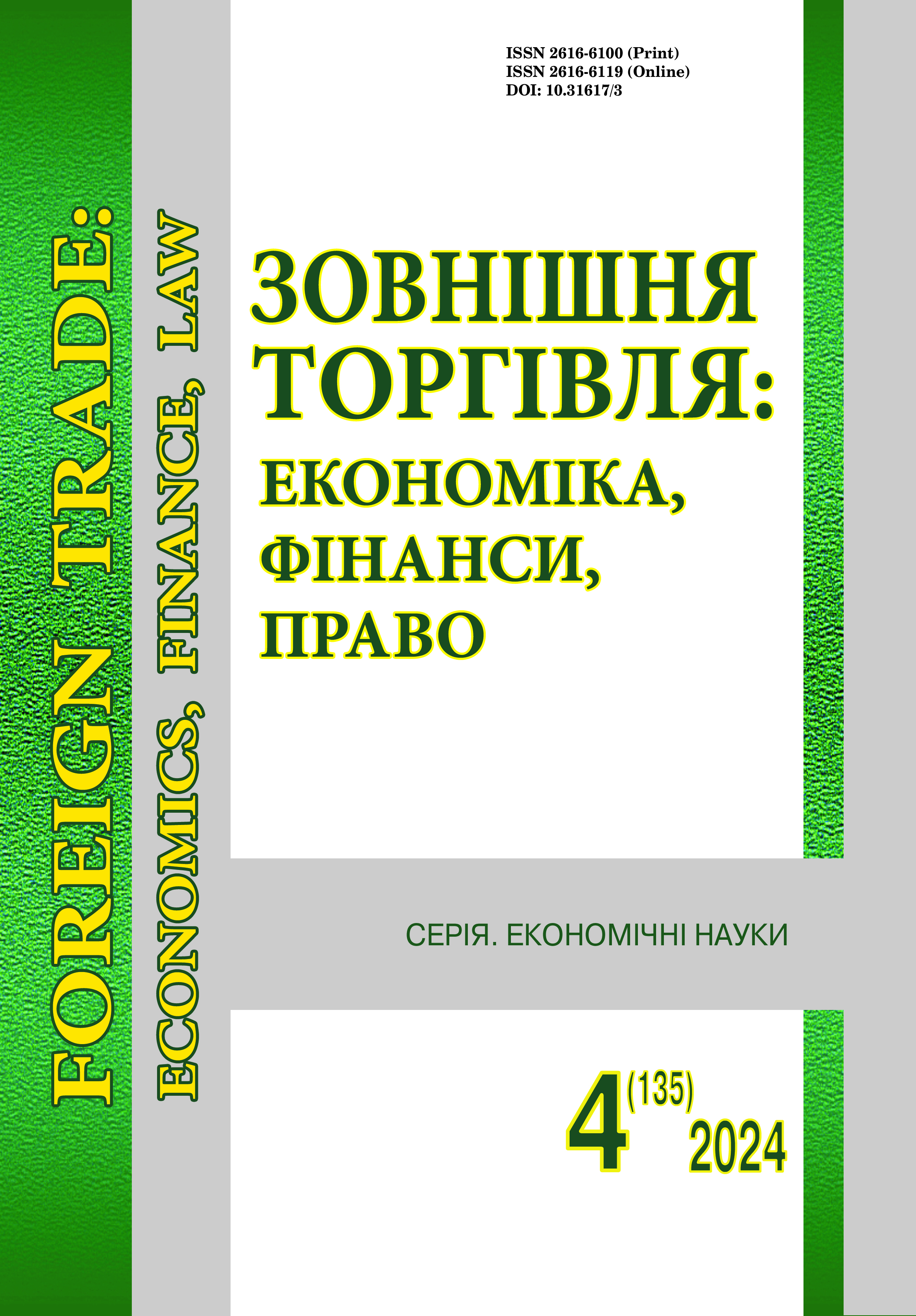Assessment of technological pressure in Ukraine – EU trade
DOI:
https://doi.org/10.31617/3.2024(135)05Keywords:
export, import, trade relations, technological pressure, asymmetry, product complexity index.Abstract
Ukrainian-European trade relations are characterized by deformation and asymmetry due to significant differences between the level of technology of goods exported from Ukraine and imported from EU countries. The purpose of the article is to assess the level of technological disparities in bilateral trade between Ukraine and the EU. The study is based on the hypothesis that there is a negative trend in the dynamics of the technological complexity of Ukraineʼs export and import goods in trade with the EU, which is a consequence of the economic asymmetry of trading partners. To confirm the hypothesis, the following methods were used: factor analysis, data normalization, and index one. The results of the calculation of the normalized average weighted indices of the technological complexity of Ukrainian exports and imports in trade with the EU illustrate that the level of technological complexity of imported products is higher compared to exported ones, and the dynamics of the Ukrainian export complexity index is negative. The results of the factor analysis of the indices of the complexity of Ukraine's export and import in trade with the EU confirm that from 2011 to 2021, the share of technologically complex products in their structure has significantly decreased. In order to analyse the asymmetry of trade relations between Ukraine and EU countries, the authors suggest using the concept of technological pressure as the difference between the values of the weighted average indices of the complexity of import and export products. The results of the calculation of the indicator of technological pressure in Ukraine's trade relations with the EU confirm the trend towards a reduction in the share of high-tech products in favour of an increase in low-tech products. The revealed trend can be interpreted as a decrease in the technological capacity of Ukraine and a source of threats to national economic security. Overcoming the unfavourable trend in the structure of Ukraineʼs trade with the EU requires the development of a strategy for the economic development of the state aimed at increasing the technological level of exported products.
References
Hidalgo, Ce'sar A., & Hausmann, R. (2009). The Building Blocks of Economic Complexity. Proceedings of the National Academy of Sciences, 106(26), 10570-10575. https://doi.org/10.1073/pnas.0900943106 DOI: https://doi.org/10.1073/pnas.0900943106
Trudova, M. Ye. (2013). Technological specialization of EU countries in conditions of global competition [Abstract of thesis of Candidate of Economic Sciences, V. N. Karazin Kharkiv National University]. Repository of V. N. Karazin KhNU. https://international-relations-tourism.karazin.ua/themes/irtb/resources/dbb6871d6a1bbeaa0148e3e04a6c2bd3.pdf
Kalyuzhna, N., & Dashkov, S. (2023). Technological specialization of export as a factor of economic growth. Foreign trade: economy, finance, law, 6(131), 4-20. https://doi.org/10.31617/3.2023(131)01 DOI: https://doi.org/10.31617/3.2023(131)01
Lee, J. (2011). Export specialization and economic growth around the world. Economic Systems, 35(1), 45-63. https://doi.org/10.1016/j.ecosys.2010.11.002 DOI: https://doi.org/10.1016/j.ecosys.2010.11.002
Zakrajsek, E., & Harrigan, J. (2006). Factor Supplies and Specialization in the World Economy. Federal Reserve Bank of New York Research Paper Series. Staff Report, (107). https://doi.org/10.2139/ssrn.933375 DOI: https://doi.org/10.2139/ssrn.933375
Nepelski, D., & De Prato, G. (2020). Technological complexity and economic development. Review of Development Economics, 24(2), 448-470. https://doi.org/10.1111/rode.12650 DOI: https://doi.org/10.1111/rode.12650
Osipova, L. (2022). The dynamics of Ukraine's exports in the conditions of a full-scale war: problems and possible ways to eliminate them in the context of European integration. Bulletin of the Khmelnytskyi National University, 6(2), 50-54. https://doi.org/10.31891/2307-5740-2022-312-6(2)-9 DOI: https://doi.org/10.31891/2307-5740-2022-312-6(2)-9
Oleshko, A., Shatska, Z., & Rovniahin, O. (2022). Smart specialization of Ukraine in the perspective of post-war economic recovery. Electronic magazine "Efficient Economy", (5). https://doi.org/10.32702/2307-2105-2022.5.9 DOI: https://doi.org/10.32702/2307-2105-2022.5.9
Kalyuzhna, N., & Kudyrko, L. (2023). Effectiveness of trade and economic integration of asymmetric countries: Assessment methods and tools. Journal of Economy and Technology., (1), 119-126. https://doi.org/10.1016/j.ject.2023.11.003 DOI: https://doi.org/10.1016/j.ject.2023.11.003
Balezhentis, A., & Yatsenko, O. (2018). Asymmetries of the trade integration of Ukraine and the EU. International economic policy, 1(28), 32-62. http://iepjournal.com/journals/28/2018_2_Basenentius_Yatsenko.pdf
Obolenska, T., Kaleniuk, I., & Yatsenko, O. (2020). Formation and implementation of trade integration potential. Bulletin of the V. V. Dokuchaev KhNAU. Series: Economic Sciences, (3), 251-263. https://doi.org/10.31359/2312-3427-2020-3-251 DOI: https://doi.org/10.31359/2312-3427-2020-3-251
Resolution of the Cabinet of Ministers of Ukraine "On the ban on the import of goods originating from the Russian Federation into the customs territory of Ukraine". https://ips.ligazakon.net/document/KP151147?an=1
State Statistics Service of Ukraine. (n. d.). Commodity structure of foreign trade. https://www.ukrstat.gov.ua/
IMF. (2022). International Monetary Fund. Download entire World Economic Outlook database. https://www.imf.org/en/Publications/WEO/weo-database/2022/April/download-entire-database
EUROSTAT Database. (2022). EU trade since 1999 by SITC [DS-018995]. https://ec.europa.eu/eurostat/web/main/data/database
Additional Files
Published
How to Cite
Issue
Section
License

This work is licensed under a Creative Commons Attribution 4.0 International License.
This work is licensed under a Creative Commons Attribution 4.0 International (CC BY 4.0)







